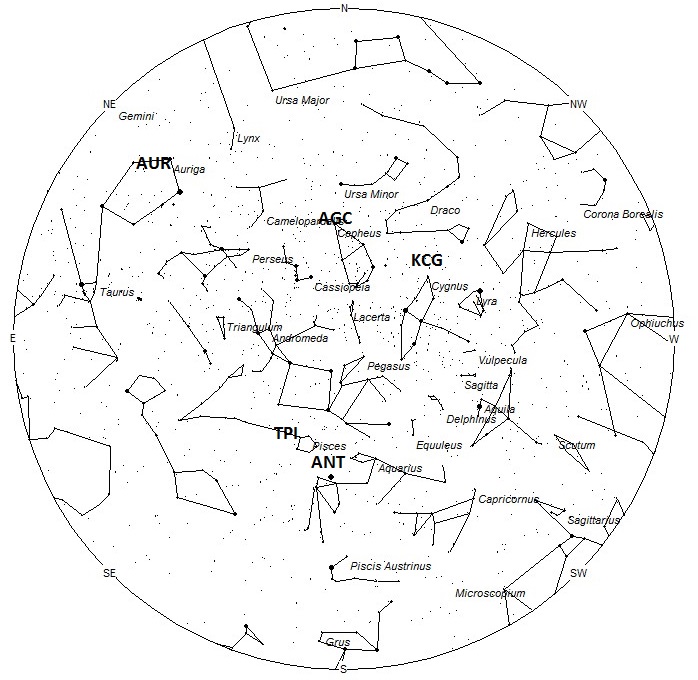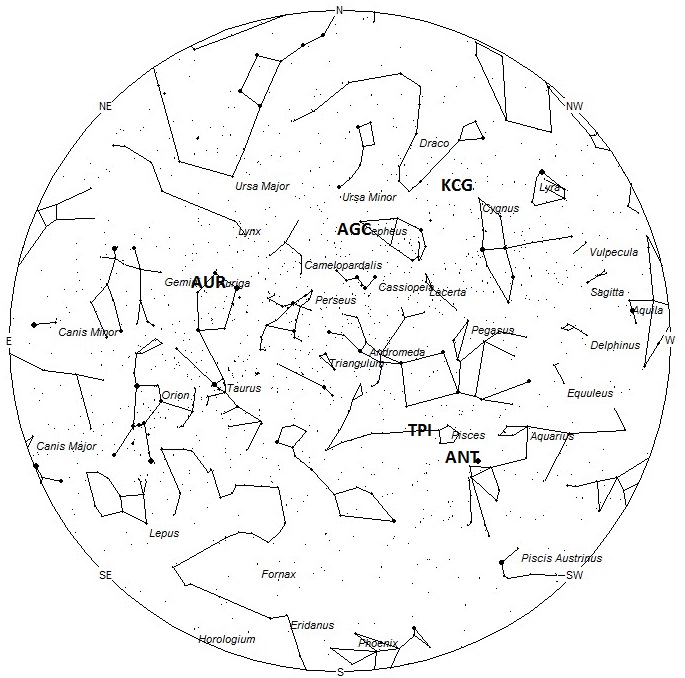September offers longer nights in the northern hemisphere that tend to be less hazy than those experienced in mid-summer. In the sky, no major showers are visible from either hemisphere but the northern hemisphere enjoys the advantage of higher sporadic rates. Most of the shower activity this month is produced from the Perseus-Aurigid complex active this time of year. These showers rarely produce more than five meteors per hour but still manage to produce most of the shower activity seen this month. Unfortunately the Perseus-Aurigid complex lies too low in the northern sky for southern hemisphere observers to view very well. Video studies have shown that the Southern Taurids are visible as early as September 7th therefore after this date the Anthelion radiant will no longer be listed until the Taurid showers end in December. The Anthelion meteors are still active but their radiant is superimposed upon that of the more numerous Taurids, therefore it is impossible to properly separate these meteors. Observers in the southern hemisphere suffer from some of their lowest rates of the year this month. The Southern Taurid radiant is not too badly placed so observers south can expect to see a little of this activity this month. Lastly, recent video data has shown that the Orionids are active all month long, even though their maximum is not until October 22nd.
During this period the moon reaches its full phase on Saturday August 29nd. This is the worse time to try and view meteor activity as the bright moonlight will obscure all but the brightest meteors. Toward the end of this period the evening skies will be free of moonlight but meteor activity will be low as the evening hours offer the lowest rates of the night. The estimated total hourly meteor rates for evening observers this week is near 2 as seen from mid-northern latitudes (45N) and 1 as seen from tropical southern locations (25S). For morning observers the estimated total hourly rates should be near 8 as seen from mid-northern latitudes (45N) and 5 as seen from tropical southern locations (25S). The actual rates will also depend on factors such as personal light and motion perception, local weather conditions, alertness and experience in watching meteor activity. Rates during this period are reduced by lunar glare. Note that the hourly rates listed below are estimates as viewed from dark sky sites away from urban light sources. Observers viewing from urban areas will see less activity as only the brightest meteors will be visible from such locations.
The radiant (the area of the sky where meteors appear to shoot from) positions and rates listed below are exact for Saturday night/Sunday morning August 29/30 These positions do not change greatly day to day so the listed coordinates may be used during this entire period. Most star atlases (available at science stores and planetariums) will provide maps with grid lines of the celestial coordinates so that you may find out exactly where these positions are located in the sky. A planisphere or computer planetarium program is also useful in showing the sky at any time of night on any date of the year. Activity from each radiant is best seen when it is positioned highest in the sky, either due north or south along the meridian, depending on your latitude. It must be remembered that meteor activity is rarely seen at the radiant position. Rather they shoot outwards from the radiant so it is best to center your field of view so that the radiant lies at the edge and not the center. Viewing there will allow you to easily trace the path of each meteor back to the radiant (if it is a shower member) or in another direction if it is a sporadic. Meteor activity is not seen from radiants that are located below the horizon. The positions below are listed in a west to east manner in order of right ascension (celestial longitude). The positions listed first are located further west therefore are accessible earlier in the night while those listed further down the list rise later in the night.
These sources of meteoric activity are expected to be active this week. Descriptions of each source will resume next week when lunar interference will not be such a problem.
| SHOWER | DATE OF MAXIMUM ACTIVITY | CELESTIAL POSITION | ENTRY VELOCITY | CULMINATION | HOURLY RATE | CLASS |
| RA (RA in Deg.) DEC | Km/Sec | Local Daylight Saving Time | North-South | |||
| Kappa Cygnids (KCG) | Aug 18 | 19:16 (289) +60 | 23 | 23:00 | <1 – <1 | II |
| Anthelions (ANT) | – | 23:19 (349) -03 | 29 | 02:00 | 2 – 2 | II |
| Theta Piscids (TPI) | Aug 20 | 23:59 (000) +08 | 39 | 03:00 | <1 – <1 | IV |
| August Gamma Cepheids (AGC) | Aug 28 | 00:06 (002) +77 | 41 | 03:00 | <1 – <1 | IV |
| Aurigids (AUR) | Sep 01 | 05:48 (087) +38 | 67 | 09:00 | 1 – <1 | III |
 American Meteor Society
American Meteor Society


